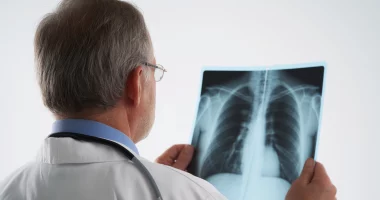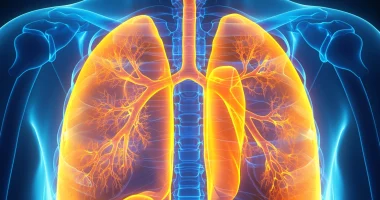Pericarditis
About the disease
Pericarditis is an acute or chronic inflammation of the pericardium. The pathologic process can affect the outer layerholding the heart in place or the fluid-filled inner cavity.
The outer cardiac sheath or pericardial pouch fixes the heart, protects it from overstretching and friction, and prevents infection from entering the myocardium (heart muscle).
Pericarditis is a severe disease that is more common in men. As a rule, patients are diagnosed with an idiopathic form, in which it is impossible to determine the cause of the disease. Still, extremely rarely does the inflammation have a primary character. Usually, pathology accompanies myocardial infarction and pneumonia.
When the pathology develops, the fluid inside the cavity of the cardiac membrane and immune cells move inside the tissues, thickening them and also forming an effusion that can prevent the heart from contracting. In the acute form, the process progresses rapidly and requires immediate cardiac care. In the chronic form, progression is slower, but the lack of treatment always causes dangerous complications of pericarditis, associated with a decrease in stroke volume and an increase in heart rate. That is, with an inflamed pericardium, it is more difficult for the heart to contract and relax.
Types of pericarditis
Depending on the cause of pericarditis, the following types are distinguished:
- idiopathic (the exact cause has not been identified);
- infectious (viral, bacterial, fungal);
- cancerous;
- associated with metabolic disease;
- associated with systemic pathologies.
Based on morphologic features, types of pericarditis include:
- dry;
- exudative (serous, purulent, putrefactive);
- constrictive (fibrotic);
- exudative-constrictive;
- with calcification;
- adhesive.
According to the duration of pericarditis classification, there are 3 types of the disease: acute (clinical manifestations of no more than 1.5 months), subacute (signs of the disease persist for up to six months), and chronic (symptoms are present for more than six months).
Symptoms of pericarditis
The main sign of an acute inflammatory process in the pericardium is pain. Unlike the sensations in ischemia (angina pectoris, infarction), it is sharp, not attack-like, increases or decreases with the change of posture, and does not change with nitroglycerin intake.
Symptoms of pericarditis may include:
- shortness of breath;
- tachycardia;
- general weakness;
- lower extremities edema;
- cough;
- fever.
When breathing in, the manifestations of the disease increase, and when bending forward from a sitting position – they decrease.
Causes of pericarditis
The most frequent types of pericarditis are idiopathic, in which it is impossible to determine the cause, as well as infectious. In the second case, the causative agents of the pathological process become:
- streptococci;
- treponema;
- chlamydia;
- meningococcus;
- Hemophilus bacillus;
- Candidas;
- parasites, protozoa;
- Coxsackie viruses;
- herpes virus;
- COVID-19;
- HIV.
Much less often, pericarditis is caused by renal failure, chest trauma, connective tissue diseases, radiation, neoplastic processes, and tuberculosis.
Diagnosis of pericarditis
At the first appointment, the doctor may detect signs of pericarditis by listening to the heart with a stethoscope, revealing the pericardium’s friction noise. If the disease is severe, there may also be wheezing when breathing, associated with pericardial effusion.
Instrumental examination for pericarditis includes:
- heart MRI;
- chest X-ray;
- an echocardiogram;
- electrocardiogram (ECG).
To identify the cause of the inflammatory process, laboratory tests are performed:
- troponin I test;
- clinical blood test, including blood counts;
- blood biochemical analysis, including C-reactive protein and rheumatoid factor;
- antinuclear antibody analysis;
- HIV test.
During the examination, it is important to differentiate the disease from pleuritis, pneumonia, angina pectoris, and pain syndrome associated with diseases of the musculoskeletal system.
Treatment of pericarditis
The therapeutic plan is made individually. Medical care is required even if the disease is asymptomatic, as the consequences of pericarditis can be very severe and life-threatening.
Conservative treatment
With the identified provocateur of pericardial inflammation, etiotropic (aimed at eliminating the cause) treatment is prescribed:
- antibiotics if the inflammation is bacterial;
- antifungal drugs for fungal pericarditis;
- antiviral agents selected with evidence-based medicine.
Symptomatic remedies normalize temperature, relieve pain, and improve sleep.
Additionally, your doctor may prescribe anti-inflammatory drugs, including corticosteroids and non-steroidal anti-inflammatory drugs, and diuretics – to remove excess fluid from the body and relieve swelling quickly.
Surgical treatment
In case of severe effusion (more than 100 ml), it is necessary to evacuate the fluid to normalize heart function quickly.
Pericardiocentesis is a puncture of the pericardium to remove fluid, blood, and pus, squeezing the heart. During the puncture, a needle is inserted through specific points under ultrasound control under local anesthesia.
The plastic catheter can be left in place 2-4 days after drainage. The fluid obtained from the procedure can be sent to the laboratory for analysis to determine the exact cause of inflammation and adjust the treatment.
When scar formation occurs, which is a characteristic of the constrictive form of pericarditis, pericardiectomy may be required to remove affected fragments of the myocardial outer membrane.
All these treatment options are available in more than 82 hospitals worldwide (https://doctor.global/results/diseases/pericarditis). For example, Pericardiocentesis is performed in 3 clinics in Spain for an approximate price of $3,919 (https://doctor.global/results/europe/spain/all-cities/all-specializations/procedures/pericardiocentesis).
Prevention of pericarditis
There are no unique methods of prevention of pericarditis. Protection from the causes of its development can reduce the risk of the disease:
- avoiding crowded places, keeping a distance from people with signs of flu-like conditions;
- hygiene, hand washing, and the use of topical antiseptics;
- vaccination against COVID-19, rubella, influenza, and other diseases can cause myocarditis.
It is also important to consult a doctor in case of infections and other conditions that can lead to pericarditis, strictly following the recommendations during treatment and rehabilitation.
Rehabilitation
After pericarditis and pericardial surgery, a recovery period is necessary to prevent the recurrence of inflammation. It is necessary to visit a cardiologist annually to examine and perform the indicated diagnostics and follow the rules of a healthy lifestyle to maintain immunity and the cardiovascular system: balanced diet, daily routine, regular and adequate physical activity, and avoidance of bad habits.





